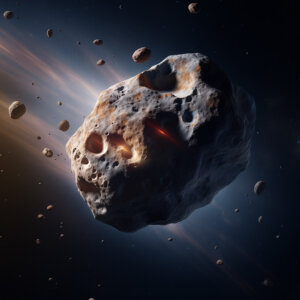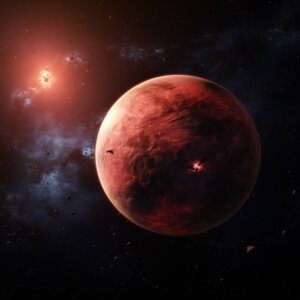SETI Institute + Unistellar Citizen Science
Asteroid Occultations
Asteroids are small, rocky bodies that orbit the Sun. Occasionally, one of these asteroids will fly in front of a distant star, blocking its light. This event, called an occultation, casts a shadow on the Earth that can be recorded by Citizen Astronomers in the shadow’s path. To capture these fleeting events, observers in the shadow turn their Unistellar telescopes to the distant star and record its flickering light as the asteroid flies by. Asteroids come in all shapes, sizes, and compositions – by studying them more closely, we can learn about such characteristics and refine these space rocks’ orbits.

Asteroids
Millions of asteroids exist in our Solar System, mostly in the Asteroid belt between Jupiter and Mars. Some even share the same orbit as the planets, revolving along with them as they circle the Sun – these asteroids are called trojan asteroids. Current scientific theory states that asteroids in the Asteroid Belt are left over debris from the creation of our Solar System. Due to the massive gravity of Jupiter, the Asteroid Belt remained in pieces instead of coalescing into a rocky planet. Since these asteroids witnessed the birth of our Solar System, studying them can tell us more about its formation and perhaps even the origins of life.
Unique Occultations
When an asteroid’s shadow is cast on Earth, it projects a unique path on a certain swath of the Earth. This shadow’s path is different for each occultation and its shape depends on the asteroid’s size and shape, so your observations can tell us a lot about a specific space rock.
If you are towards the center of the shadow, your observation tells us about the middle of the asteroid, and vice versa – you look at the edge of the asteroid by observing near the shadow’s edge. Since each part of the shadow corresponds to a different part of the asteroid, occultations have slightly different durations depending on where you are in the shadow. By studying the duration you observe from your place in the asteroid’s shadow, scientists can gather occultation chords. A chord is a representation of these two pieces of information, and they map the projected shape of the asteroid on Earth. This is how your unique observations can help scientists to determine an asteroid’s shape!


Your Contribution
Occultations by asteroids happen quite frequently, at least once a night, so there is always something to observe! Each occultation can last for just seconds, making observations of them highly desirable and exciting.
To start hunting asteroid shadows, visit our New Missions page to see what events are visible to you. Head to the Tutorial page for guidance on how to master your Unistellar telescope. The exciting results from Citizen Astronomers’ observations of asteroids are posted on the Results page, so you can see what kind of discoveries you will be making!



